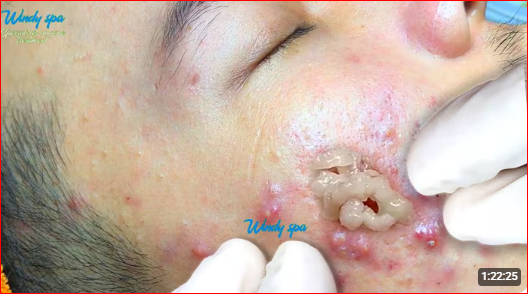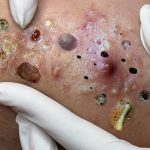🔹 1. Blackhead Treatment
A blackhead is an open comedone where the pore is clogged with oil and dead skin.
✅ Do:
-
Cleanse Gently: Use a mild cleanser with salicylic acid or benzoyl peroxide to dissolve oil and dead skin.
-
Exfoliate: 2–3 times a week with a chemical exfoliant (like glycolic or lactic acid).
-
Apply Retinoids: Over-the-counter retinoids (like adapalene) can help clear and prevent blackheads.
-
Use Non-comedogenic Products: Avoid makeup or skincare that clogs pores.
❌ Don’t:
-
Squeeze or Pick: It can lead to inflammation, infection, or scarring.
-
Over-wash: This can strip your skin, causing more oil production.
🔹 2. Previously Inflamed Cyst
A cyst (like an acne cyst) that was swollen and painful but has now subsided still needs care, especially if there’s a bump or scar left.
✅ Do:
-
Leave It Alone: Don’t pick or squeeze it, especially if it’s healing.
-
Apply Warm Compresses: Helps with residual swelling or hardness.
-
Use a Gentle Spot Treatment: Niacinamide or azelaic acid can reduce redness and post-acne marks.
-
Consider Scar Treatment: Silicone gels, onion extract (e.g., Mederma), or prescription creams can help flatten and fade scars.
-
Moisturize and Protect: Use sunscreen to prevent dark marks from worsening.
❌ Don’t:
-
Try to “Pop” it: If it’s under the skin or healing, squeezing can make it worse.
-
Use Harsh Scrubs: These can aggravate healing skin.
When to See a Dermatologist:
-
If the blackhead keeps coming back or clusters into acne.
-
If the cyst becomes painful again, grows, or turns red/purple.
-
For treatment options like cortisone injections, professional extraction, or laser/scar therapy.
🖤 Blackhead Treatment
Blackheads are open comedones formed when hair follicles become clogged with oil and dead skin cells. The exposure to air causes the debris to oxidize, resulting in the characteristic dark appearance.
✅ Recommended Treatments
-
Salicylic Acid: A beta hydroxy acid (BHA) that penetrates pores to exfoliate and dissolve the debris causing blockages. It’s effective for treating and preventing blackheads. Real Simple+1Verywell Health+1
-
Benzoyl Peroxide: Works by killing acne-causing bacteria and reducing inflammation. It’s particularly useful for inflamed blackheads and can be found in various over-the-counter products.
-
Retinoids (e.g., Adapalene): Promote cell turnover and prevent the formation of comedones. Over-the-counter options like Differin are available, and they can be used nightly.
❌ Avoid
-
Manual Extraction: Popping or squeezing blackheads can lead to scarring and further inflammation.
-
Harsh Scrubs: Can irritate the skin and exacerbate acne.
⚠️ Previously Inflamed Cyst Treatment
A cystic acne lesion is a deep, painful bump under the skin. Even after inflammation subsides, residual scarring or hardness may persist.
✅ Recommended Treatments
-
Warm Compresses: Applying a warm compress can help reduce residual swelling and promote healing.
-
Niacinamide: A form of vitamin B3 that reduces inflammation and can help with post-acne marks.
-
Azelaic Acid: Effective for treating post-inflammatory hyperpigmentation and can help fade dark spots left by cystic acne.
-
Scar Treatments: Silicone gels or onion extract-based products can help flatten and fade scars over time.
❌ Avoid
-
Picking or Squeezing: Can lead to further inflammation and scarring.
-
Harsh Exfoliants: May irritate healing skin and worsen scarring.
🧴 Sample Skincare Routine
| Step | Morning | Evening |
|---|---|---|
| Cleanser | Salicylic acid-based cleanser | Gentle, non-drying cleanser |
| Treatment | Niacinamide serum | Retinoid (e.g., Adapalene) |
| Moisturizer | Non-comedogenic moisturizer | Moisturizer with ceramides |
| Sunscreen | Broad-spectrum SPF 30+ | (if daytime) |
| Spot Treatment | Benzoyl peroxide (if inflamed) | Azelaic acid for scars |
📌 Additional Tips
-
Consistency is Key: Treatments may take several weeks to show visible results.
-
Sun Protection: Always apply sunscreen during the day, especially when using products that increase sun sensitivity.
-
Consult a Dermatologist: If over-the-counter treatments aren’t effective, a dermatologist can provide prescription options like topical antibiotics or corticosteroid injections.


